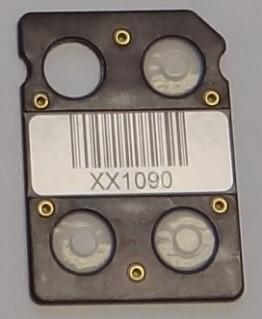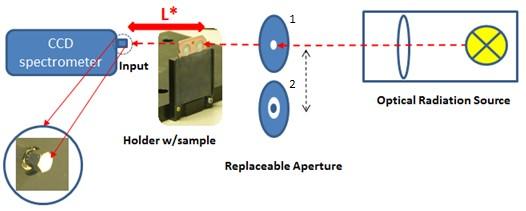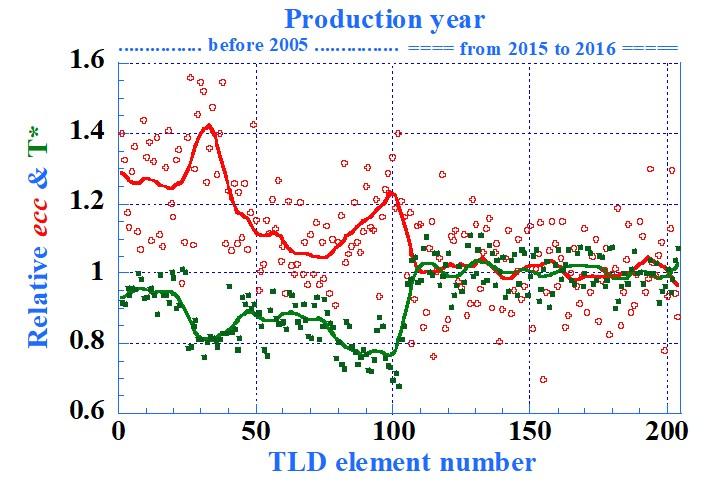Summary
The radiation sensitivity of a Thermoluminescent Dosimeter (TLD) is defined as dosimeter light output per dose unit. TLD light output depends not only on the sensitivity of the TLD elements (Fig.1) but also on the transparency of the Teflon® used for their encapsulation. The effect of encapsulation material on sensitivity of TLDs was investigated by the comparison of Teflon® transparency in the TLD cards calibrated to the same dose.
Description

The radiation sensitivity of a Thermoluminescent Dosimeter (TLD) is defined as dosimeter light output per dose unit. TLD light output depends not only on the sensitivity of the TLD elements (Fig.1) but also on the transparency of the Teflon® used for their encapsulation. The effect of encapsulation material on sensitivity of TLDs was investigated by the comparison of Teflon® transparency in the TLD cards calibrated to the same dose.
The transparency measurement of the Teflon® encapsulation film is performed at experimental setup presented in Fig. 2. The light from the source was collected by an optical system and directed to a replaceable aperture. It was placed in front of the TLD card opening so that only the Teflon® film area was illuminated. Two types of apertures were utilized in this study: one had a collimator hole with a diameter of 1 mm (#1 in Fig. 2) while the other was a ring-type (#2 in Fig. 2). The ring-type aperture provided better results due to a larger area and more effective light collection. Optical measurements were performed by a multichannel spectrometer equipped with a holographic grating and a charge-coupled device. Simultaneously covered spectral range was available between 200 nm and 850 nm. The maximum of the thermoluminescence emission of the LiF:Mg,Cu,P is about 350 nm.

The correlation between Teflon® transparency T* and ecc of TLD element is shown in Fig. 3. The sequence of the measurements was designed so that a smaller TLD element number on x-axis of Fig. 3 indicates earlier production of the TLD card. Both sets of data were normalized so that the average data value for the most recently produced cards would be unity. The ecc values measured for 204 calibrated TLD elements presented in Fig. 3 as open circles indicate significant differences depending on the year of the production. The TLD elements produced before 2005 have significantly higher ecc (lower sensitivity) values than TLD elements produced in 2015-2016. The maximum difference is up to 100%. Corresponding transparency measurements of Teflon® film (closed squares in Fig. 3) also demonstrate similar but opposite dependence, e.g. the transparency of the Teflon® film in the most recently produced TLDs is higher. The accuracy of transparency measurements is sufficient for comparison to ecc. The increases of the ecc values and the opposite drop of transparency for the individual TLD elements are shown in the left part of the Fig. 3 displaying the aged TLD cards. The observed trend of the curves including the ecc maxima (the lowest sensitivity) and their coincidence with transparency minimums clearly indicates the correlation of Teflon® transparency with ecc values.

Results obtained for 204 calibrated TLD elements indicate the direct correlation of radiation sensitivity of TLD cards and their Teflon® encapsulation transparency. It was found that Teflon® transparency is a primary cause of the radiation sensitivity increase in the most recently produced dosimetric cards. Practically this means that transparency of Teflon encapsulation holding the LiF:Mg,Cu,P element in the TLD card may contributes to the value of ecc of TLD element calibrated to the same radiation dose. Variations of both the ecc and optical transparency are stronger in the aged TLD cards. Additionally, the transparency of the LiF:Mg,Cu,P material itself may affect the ecc although the appearance is different from the related features in Teflon®. This effect is also stronger in the aged TLD cards. As follows from this study, a Teflon transparency control if established at the production site would significantly improve the ecc uniformity for the TLD cards.

